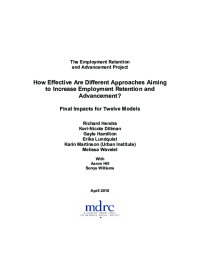How Effective Are Different Approaches Aiming to Increase Employment Retention and Advancement?
Final Impacts for Twelve Models
Research completed since the 1980s has yielded substantial knowledge about how to help welfare recipients and other low-income individuals prepare for and find jobs. Many participants in these successful job preparation and placement programs, however, ended up in unstable, low-paying jobs, and little was known about how to effectively help them keep employment and advance in their jobs. The national Employment Retention and Advancement (ERA) project sought to fill this knowledge gap, by examining over a dozen innovative and diverse employment retention and advancement models developed by states and localities for different target groups, to determine whether effective strategies could be identified.
Using a random assignment research design, the ERA project tested the effectiveness of programs that attempted to promote steady work and career advancement for current and former welfare recipients and other low-wage workers, most of whom were single mothers. The programs — generally supported by existing public funding, not special demonstration grants — reflected state and local choices regarding target populations, goals, ways of providing services, and staffing. The ERA project is being conducted by MDRC, under contract to the Administration for Children and Families (ACF) in the U.S. Department of Health and Human Services, with additional funding from the U.S. Department of Labor. This report presents the final effectiveness findings, or impacts, for 12 of the 16 ERA programs, and it also summarizes how the 12 programs were implemented and individuals’ levels of participation in program services.
Key Findings
- Out of the twelve programs included in the report, three ERA programs produced positive economic impacts; nine did not. All three programs increased employment retention and advancement. Increases in employment retention and earnings were largest and most consistent over time in the Texas ERA program in Corpus Christi (one of three sites that operated this program); the Chicago ERA program; and the Riverside County, California, Post-Assistance Self-Sufficiency (PASS) ERA program. These programs increased annual earnings by between 7 percent and 15 percent relative to control group levels. Each of them served a different target group, which suggests that employment retention and advancement programs can work for a range of populations. However, three-fourths of the ERA programs included in this report did not produce gains in targeted outcomes beyond what control group members were able to attain on their own with the existing services and supports available in the ERA sites.
- Increases in participation beyond control group levels were not consistent or large, which may have made it difficult for the programs to achieve impacts on employment retention and advancement. Engaging individuals in employment and retention services at levels above what they would have done in the absence of the programs was a consistent challenge. In addition, staff had to spend a lot of time and resources on placing unemployed individuals back into jobs, which made it difficult for them to focus on helping those who were already working to keep their jobs or move up.
Before the ERA project began, there was not much evidence about the types of programs that could improve employment retention and advancement outcomes for current or former welfare recipients. The ERA evaluation provides valuable insights about the nature of retention and advancement problems and it underscores a number of key implementation challenges that a program would have to address. In addition, it reveals shortcomings in a range of common approaches now in use, while identifying three distinct approaches that seem promising and worthy of further exploration.






